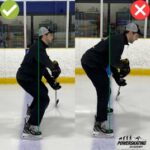We are starting a new blog series and it will be about our foundations of skating. The first topic we want to address is posture; it is one of the two most important building blocks of skating. Posture is the orientation of our body in space; it can be thought as the framework of our movement and is dependant on many things. Some factors that affect posture are bad muscle memory, muscle tightness, muscle weakness, injuries, and body contact. Most of these factors are compensations, but they all have one common theme: they move your centre of gravity (CoG) away from  its normal position. Your CoG is about two inches behind your belly button in a neutral standing position; if it moves too far in one direction, you will fall. When you lean to one side, there is more weight on that side, moving your CoG to that side. In a squatting position, your hips move slightly backwards, and your chest moves slightly forwards—this moves your CoG forward, outside of your body. Note that when we are squatting on the ice, it is important that our weight stays on the back half of the blade when you are preparing to skate forward; this allows us to generate the most power for our forward stride. Remember, great posture doesn’t create great skating—it enables great skating.
its normal position. Your CoG is about two inches behind your belly button in a neutral standing position; if it moves too far in one direction, you will fall. When you lean to one side, there is more weight on that side, moving your CoG to that side. In a squatting position, your hips move slightly backwards, and your chest moves slightly forwards—this moves your CoG forward, outside of your body. Note that when we are squatting on the ice, it is important that our weight stays on the back half of the blade when you are preparing to skate forward; this allows us to generate the most power for our forward stride. Remember, great posture doesn’t create great skating—it enables great skating.
The easiest way to get great posture on the ice is to start with great posture. It is much harder to correct posture mid stride than maintain the starting posture. If you can’t perform the proper posture stationary, you won’t be able to do it moving or under pressure during a game. This is why we make all our skaters start in their “set-up” position before every drill. In the set-up position, we look for a couple of things: your skates should be around shoulder width apart, with their skate blade on a slight inside edge, your knees should be bent to around a quarter squat, your hips should be underneath your body (not sticking out behind you), your chest should be upright (we should be able to see the logo easily), your head should be in a neutral position with your eyes looking forward, and your hands are should both be on your stick, in front and away from your hips with a slight bend in the elbow of your grip hand.
We find this position to be the most advantageous to start skating from and handle a puck from. Your feet are close enough where you can maximize your stride length, your knee bend has your quads loaded for a push, your chest is up maintaining good balance, your eyes are up and ready to scan your surrou ndings, and your hands are away from your body allowing them to move freely for or with a puck.
ndings, and your hands are away from your body allowing them to move freely for or with a puck.
The most common mistake we see skaters make is having their chest down. As we mentioned earlier our posture moves our CoG; with your chest down, your CoG moves forward even more. Our body compensates by straightening our knees, moving our hips further back, and putting our weight on the front half of the blade instead of over firing our back and abdominal muscles. It is important to note that your thorax is the heaviest segment of the body, followed by your pelvis. That means if you move your chest forward by 3 inches, you’ll need to move your hips back by more than 3 inches to keep your CoG in the same position. Any gentle nudge pushing down on the small of your back will send you flying backward or any push on your upper back will send you face planting.
Our coaches want skaters to try to maintain the posture in the set-up position throughout the entire drill because it is the most efficient position to generate a powerful stride, while being balanced and in control. If you have any questions email us at info@powerskatingacademy.com or DM us on Instagram or Facebook!
See you on the ice!
Dave Levtov

Recent Comments